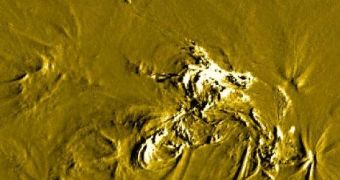The surface of the sun is now mistakenly perceived as the photosphere.
The photosphere is the region where the sun stops being transparent to ordinary light. Because stars are believed to have no solid surface, the photosphere is typically used to describe the Sun or another star's visual surface.
The Sun's photosphere has a temperature of about 5800 kelvins and a density of about 2/10 000 kg cubic meter. It's composed of convection cells called granules - firestorms each approximately 1000 kilometers in diameter with hot rising gas in the center and cooler gases falling in the narrow spaces between them.
In reality however, the sun's photosphere could be a "liquid-like" plasma layer made of neon that covers the actual surface of the sun.
The visible photosphere covers the transitional region that is the actual surface of the sun, much as the earth's oceans cover most of the surface of the earth. In this case the sun's photosphere is very bright and we cannot see the darker surface features below without the aid of satellite technology.
For thousands of years, the composition and mechanical inner workings of the sun beneath the visible photosphere have remained an enigma.
There are a whole host of unexplained phenomena related to the sun's activities that still baffle gas model theorists to this day because they fail to recognize the existence of an iron alloy transitional layer that rests beneath the visible photosphere.
Fortunately, a host of new satellites and the field of heliosiesmology are starting to shed new light on this mysterious transitional layer of the sun that is located about 4800km beneath the visible photosphere. In addition, recent studies of solar wind suggest that solar wind also originates on the same transition layer under the photosphere as do the electrically charged coronal loops.
NASA's SOHO satellite and the Trace satellite program have both imaged this transition layer of the sun that sits beneath the photosphere. These 21st century satellites and technologies now enable us to peer behind the outer plasma layers of the chromosphere and photosphere and allow us to study the rocky, calcium ferrite transitional layer with incredible precision.
The gas model sun was founded by Galileo, observed the sun through a relatively primitive telescope and noticed that sunspots did not rotate uniformly across the surface of the photosphere. He also observed that this visible "surface" rotated at different speeds near the equator than it did near the poles.
From his study of sunspots and their uneven movement, Galileo surmised that he must be looking at some type of gas. He was correct in that assessment, although today we know that the photosphere is a form of hot ionized plasma.
Unfortunately, Galileo also "assumed" that no other solid layers existed, or could exist beneath the visible layer of the photosphere. That was a critical mistake. It was a bit like looking at a world covered in water, and having no ability to see beneath the water and simply assuming that the whole world is made of water.
The running difference imaging technique used by both NASA and Lockheed Martin have revealed to us for the first time that the sun is not simply a ball of hydrogen gas in space; it has a hard and rigid ferrite surface below the visible photosphere that can be seen in all of the images.
Studies of quasars in the early universe demonstrate the presence of large quantities of iron, casting serious doubt on the gas model in recent years.
In addition, there is now growing evidence from the field of heliosiesmology that the sun possesses a significant stratification layer at a very shallow depth from the top of the photosphere.
This new data suggest that the sun in fact has a stratified iron surface, covered by a relatively thin veneer of plasma layers.

 14 DAY TRIAL //
14 DAY TRIAL //